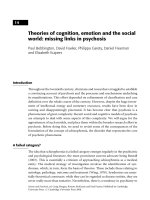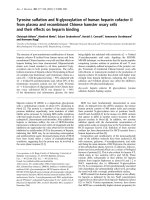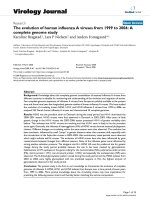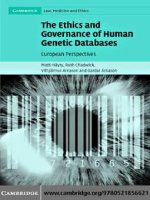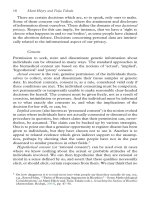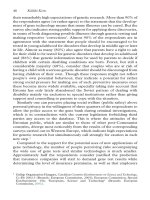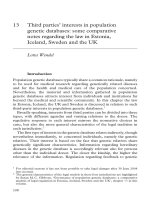Analysis and detection of human emotion and stress from speech signals
Bạn đang xem bản rút gọn của tài liệu. Xem và tải ngay bản đầy đủ của tài liệu tại đây (3.17 MB, 230 trang )
ANALYSIS AND DETECTION OF HUMAN EMOTION AND
STRESS FROM SPEECH SIGNALS
TIN LAY NWE
NATIONAL UNIVERSITY OF SINGAPORE
2003
ANALYSIS AND DETECTION OF HUMAN EMOTION AND STRESS
FROM SPEECH SIGNALS
TIN LAY NWE
(B.E (Electronics), Yangon Institute of Technology)
A THESIS SUBMITTED
FOR THE DEGREE OF DOCTOR OF PHILOSOPHY
DEPARTMENT OF ELECTRICAL AND COMPUTER ENGINEERING
NATIONAL UNIVERSITY OF SINGAPORE
2003
To my parents.
i
Acknowledgments
I wish to express my sincere appreciation and gratitude to my supervisors, Dr.
Liyanage C. De Silva and Dr. Foo Say Wei for their encouragement and tremendous
effort in getting me into the PhD program. I am greatly indebted to them for their time
and effort they spent with me over the past three years in analyzing problems I faced
throughout the research. I would like to acknowledge their valuable suggestions,
guidance and patience during the course of this work.
I owe my thanks to Ms. Serene Oe and Mr. Henry Tan from Communication
Lab, for their help and assistance. Thanks are also given to all of my lab mates for
creating an excellent working environment and a great social environment.
I would like to thank my friend, Mr. Nay Lin Htun Aung, and other friends
who helped me throughout the research.
Special thanks must go to my parents, my sister, Miss Kyi Tar Nwe and other
family members for their support, understanding and encouragement.
ii
Table of Contents
Acknowledgements i
Table of Contents ii
Summary vi
List of Symbols viii
List of Figures x
List of Tables
xv
Chapter 1: Introduction
1
1.1 Automatic Speech Recognition (ASR) in Adverse Environments 2
1.2 Importance of Implicit Information in Human-Machine Interaction 4
1.3 Review of Robust ASR Systems 6
1.4 Motivation of This Research 7
1.5 System Overview 8
1.6 Purpose and Contribution of This Thesis 10
1.7 Organization of Thesis 11
Chapter 2: Review of Acoustic Characteristics and Classification
Systems of Stressed and Emotional Speech 12
2.1 The Effects of Stress and Emotion on Human Vocal System 12
2.2 Acoustic Characteristics of Stressed and Emotional Speech
15
iii
2.3 Social and Cultural Aspects of Human Emotions 21
2.4 Reviews of Analysis and Classification Systems of Stress and
Emotion 28
2.5 Summary 34
Chapter 3: Stressed and Emotional Speech Corpuses 35
3.1 Stressed Speech Database 36
3.2 Database Formulation of Emotional Speech 38
3.2.1 Preliminary Subjective Evaluation Assessments 43
3.3 Noisy Stressed and Emotional Speech 45
3.4 Summary 48
Chapter 4: Experimental Performance Evaluation for
Existing Methods 50
4.1 Acoustic Processing 51
4.1.1 Computation of Fundamental Frequency 51
4.1.2 Short-Term Energy Measurement 53
4.1.3 Power Spectral Density 55
4.1.4 Formant Location and Bandwidth 57
4.2 Feature Data Preparation and Analysis 59
4.2.1 Statistics of Basic Speech Features 60
4.2.2 Feature Selection 62
4.2.3 Feature Data Analysis 64
iv
4.3 Classifiers and Experimental Designs 68
4.3.1 Backpropagation Neural Network (BPNN) 69
4.3.2 K-means Algorithm 70
4.3.3 Self Organizing Maps (SOM) 70
4.4 Stress and Emotion Classification Results and Experimental
Evaluations 70
4.5 Comparison with Existing Studies 75
4.6 Summary 77
Chapter 5: Subband Based Feature Extraction Methods
and Analysis
79
5.1 Selection of Stress and Emotion Classification Features 80
5.2 Feature Extraction Techniques for Stress and Emotion
Classification 83
5.2.1 Preprocessing of Speech Signals 84
5.2.2 Computation of Subband Based Novel Speech Features 86
5.2.3 Traditional Features 97
5.3 Analysis of LFPC based Feature Parameters in Time-Frequency
Plane 102
5.4 Statistical Analysis of Feature Parameters 113
5.5 Summary 124
v
Chapter 6: Evaluation of Stress and Emotion
Classification Using HMM 125
6.1 HMM Classifier for Stress/Emotion Classification 126
6.1.1 Vector Quantization (VQ) 130
6.2 Conduct of Experiments 132
6.2.1 Results of Stress Classification 135
6.2.2 Results of Emotion Classification 136
6.3 Discussion of Results 137
6.4 Performance Analysis under Different System Parameters 142
6.5 Performance Analysis under Noisy Conditions 147
6.6 Performance of Other Methods 150
6.7 Summary 152
Chapter 7: Conclusions and Directions for Future Research 154
References
160
Author’s Publications 182
Appendix A 184
Appendix B 190
Appendix C 204
Appendix D 208
vi
SUMMARY
Intra-speaker variability due to emotion and workload stress is one of the major factors
that degrade the performance of an Automatic Speech Recognition (ASR) system. A
number of studies have been conducted to investigate acoustic indicators to detect
stress and emotion in speech. The majority of these systems have concentrated on the
statistics extracted from pitch contour, energy contour, wavelet based subband features
and Teager-Energy-Operator (TEO) based feature parameters. These systems work
mostly on pair-wise distinction between neutral and stressed speech or classification
among few emotion categories. Their performances decrease when more than a couple
of emotion or stress categories have to be classified even in noise free environments.
The focus of this thesis is on the analysis and classification of emotion and
stress utterances in noise free as well as in noisy environments. The classification
among many stress or emotion categories is considered. To obtain better classification
accuracy, analysis of characteristics of emotion and stress utterances are carried out
using several combinations of traditional features. Subsequently, more reliable acoustic
features are investigated. This approach offers to search for the best set of traditional
features that are the most suitable for stress detection analysis. Based on the types of
traditional selected features, new and more reliable acoustic features are formulated.
In this thesis, a novel system is proposed using linear short time Log Frequency
Power Coefficients (LFPC) and TEO based nonlinear LFPC features in both time and
frequency domain. The performances of the LFPC feature parameters are compared
with that of the Linear Prediction Cepstral Coefficients (LPCC) and Mel-frequency
vii
Cepstral Coefficients (MFCC) feature parameters commonly used in speech
recognition systems. Four-state Hidden Markov Model (HMM) with continuous
Gaussian mixture distribution is used as a classifier.
Proposed system is evaluated for multi-style, pair-wise and grouped
classifications using data from ESMBS (Emotional Speech of Mandarin and Burmese
Speakers) emotion database that is build for this study and SUSAS (Speech Under
Simulated and Actual Stress) stress database (produced by Linguistic Data
Consortium) under noisy and noise free conditions.
The newly proposed features outperform the traditional features and average
recognition rates increase from 68.6% to 87.6% for stress classification and from
67.3% to 89.2% for emotion classification using LFPC feature. It is also found that the
performance of linear acoustic features LFPC is better than that of nonlinear TEO
based LFPC features. Results of test of the system under different signal-to-noise
conditions show that the performance of the system does not degrade drastically with
increase in noise. It is also observed that classification using nonlinear frequency
domain LFPC features gives relatively higher accuracy than that using nonlinear time
domain LFPC features.
viii
List of Symbols
x
mean
σ
standard deviation
M
J
periodogram
w
x
x
B power spectrum estimate
()
A
z inverse filter
ˆ
B
raw data of formant bandwidth
ˆ
F
raw data of formant frequency
s
f
sampling frequency
p
N number of peaks
*
i
z
new centroid of cluster
i
K
number of cluster centers
i
m
weight vector of cell
i
in self organizing map
c winning neuron
c
N
neighbours of winning neuron
i
f
center frequency of
th
i
subband
i
b
bandwidth of
th
i
subband
α
logarithmic growth factor
C
bandwidth of first filter
m
l lower edge of
th
m filter bank
m
h upper edge of
th
m
filter bank
()
t
Sm
th
m
filter bank output at time
t
ix
)(kX
t
k
th
spectral component of speech frame at time t
)(
mSE
t
energy of
th
m filter bank
m
N number of spectral components in the
th
m
filter bank
[()]
x
nΨ
Teager energy operator
()
t
yk
th
k
Mel-Frequency Cepstral Coefficient at frame t
()
t
Ym
th
m filter bank coefficient at frame t
p
number of linear predictor coefficients
m
a
th
m linear predictor coefficient
2
σ
gain term
µ
normalization factor
()
m
ct∆
th
m cepstral time derivative at frame t
M Elias coefficient
p
1
(x) probability densities of feature distribution x
,ij
a
state transition probability from state i to the state j
()t
x
feature vector at time t
()
()
it
bx
observation probability of the feature vector
()t
x
given the state i
x
List of Figures
1.1 Block diagram of the stress/emotion classification system 8
3.1 Time waveforms and respective spectrograms of the word
‘destination’ spoken by male speaker from SUSAS database
in noise free and noisy conditions. Noise is additive white
Gaussian at a 10dB signal-to-noise-ratio 46
3.2 Time waveforms and respective spectrograms of Disgust and
Fear emotions of Burmese and Mandarin speakers from
emotion database in noise free and noisy conditions. Noise
is additive white Gaussian at a 10dB signal-to-noise-ratio 47
4.1 Classification frame work 50
4.2 Fundamental frequency contour of the word ‘strafe’ by
male speaker (SUSAS database) 52
4.3 Fundamental frequency contour of the female speaker
(ESMBS database) 53
4.4 Energy contours of the word ‘go’ by male speaker
(SUSAS database) 54
4.5 Energy contours of the female speaker (ESMBS database) 55
4.6 Power Spectral Density contour of the word ‘hello’ by
male speaker (SUSAS database) 56
4.7 Power Spectral Density contour of the female speaker
(ESMBS database) 57
4.8 First and Second formant frequencies of the word
‘strafe’ by male speaker (SUSAS database) 58
4.9 First and Second formant frequencies of female speaker
(ESMBS database) 59
5.1 Waveforms of a segment of the speech signal produced
under (a) Neutral and Anger conditions of the word ‘go’
by a male speaker (200ms duration) (b) Sadness and Anger
emotions spoken by Burmese female speaker (200ms duration) 80
5.2 Hamming window function 85
5.3 Subband frequency divisions for (a) Stress utterances
(b) Emotion utterances 89
xi
5.4 (a) Nonlinear time domain LFPC feature extraction
(b) nonlinear frequency domain LFPC feature extraction 91
5.5(a) Wave forms of 25ms segments of the utterances spoken
by a Burmese female speaker under six emotion
conditions (ESMBS database) 93
5.5 (b) Teager Energy operation of the signals
(Figure 5.5(a)) in the time domain. 93
5.5(c) Teager Energy operation of the signals
(Figure 5.5(a)) in the frequency domain. 94
5.5(d) Intensity variation of the signals
(Figure 5.5(a)) in the frequency domain. 94
5.6(a) Wave forms of 25ms segment of the word ‘destination’
spoken by a male speaker under five stress conditions
(SUSAS database) 94
5.6(b) Teager Energy operation of the signals (Figure 5.6(a))
in the time domain. 95
5.6(c) Teager Energy operation of the signals (Figure 5.6(a))
in the frequency domain. 95
5.6(d) Intensity variation of the signals (Figure 5.6(a))
in the frequency domain. 95
5.7 LFPC based Log energy spectrum of noise free utterances
of Burmese female speaker (ESMBS database) 103
5.8 LFPC based Log energy spectrum of noisy utterances
(20dB white Gaussian noise) of Burmese female
speaker (ESMBS database) 104
5.9 NFD-LFPC feature based Log energy spectrum of
(a) noise free utterances (b) noisy utterances
(20dB white Gaussian noise) of Mandarin female
speaker (ESMBS database) 105
5.10 NTD-LFPC feature based Log energy spectrum of
(a) noise free utterances (b) noisy utterances
(20dB white Gaussian noise) of Mandarin male speaker
(ESMBS database) 106
5.11 LFPC feature based Log energy spectrum of noise free
utterances of the word ‘white’ by male speaker (SUSAS database) 107
5.12 LFPC feature based Log energy spectrum of noisy
xii
utterances (20dB white Gaussian noise) of the word
‘white’ by male speaker (SUSAS database) 108
5.13 NFD-LFPC feature based Log energy spectrum of
(a) noise free utterances (b) noisy utterances
(20dB white Gaussian noise) of the word ‘white’ by
male speaker (SUSAS database) 109
5.14 NTD-LFPC feature based Log energy spectrum of
(a) noise free utterances (b) noisy utterances
(20dB white Gaussian noise) of the word ‘white’
by male speaker (SUSAS database) 110
5.15 Distribution of (a) LFPC (b) NFD-LFPC
(c) NTD-LFPC features of utterances of Burmese male
speaker (ESMBS database). The abscissa represents
‘Log-Frequency Power Coefficient Values’
and the ordinate represents ‘Percentage of Coefficients’ 115
5.16 Distribution of (a) MFCC and (b) LPC (upper row)
and delta LPC (Lower row) coefficient values of
utterances of Burmese male speaker (ESMBS database).
The abscissa represents ‘Coefficient Values’ and the
ordinate represents ‘Percentage of Coefficients’. 116
5.17 Distribution of (a) LFPC (b) NFD-LFPC (c) NTD-LFPC
features of utterances of male speaker (SUSAS database).
The abscissa represents ‘Log-Frequency Power Coefficient
Values’ and the ordinate represents ‘Percentage of Coefficients’. 117
5.18 Distribution of (a) MFCC and (b) LPC (upper row)
and delta LPC (Lower row) coefficient values of utterances
of male speaker (SUSAS database). The abscissa represents
‘Coefficient Values’ and the ordinate represents ‘Percentage
of Coefficients’. 118
5.19 Elias Coefficients of noise free utterances of (a) Burmese
male speaker (ESMBS emotion database) using Anger
and Sadness emotions (b) male speaker (SUSAS stress database)
using Anger and Lombard stress conditions 121
5.20 Comparison of Elias coefficients across 5 feature
parameters using Burmese male and female, Mandarin
male and female noise free utterances (ESMBS database) 121
5.21 Comparison of Elias coefficients across 5 feature parameters
using Burmese male and female, Mandarin male and female
utterances at SNR of 20dB additive white Gaussian noise
(ESMBS database) 122
xiii
5.22 Comparison of Elias coefficients across 5 feature
parameters using noise free and noisy (SNR of 20dB
additive white Gaussian noise) utterances of male 122
speaker (SUSAS data base)
6.1 Stress/emotion classification system using HMM recognizer 126
6.2 (a) Left-right model HMM (b) Ergodic model HMM 127
6.3 Illustration of sequence of operations required for computation
of probability of observation sequence
X
given by the 4 state
ergodic model HMM 129
6.4 Comparison of average emotion classification performance
of Mandarin and Burmese languages (ESMBS database) 141
6.5 Comparison of stress/emotion classification system performance
(a) across different alpha values (b) before and after removing
F0 information in feature parameter formulation. 143
6.6 Comparison of stress/emotion classification system performance
(a) across different window sizes and frame rates
(b) under various HMM states. 145
6.7 Waveform and state transition diagrams of Disgust utterance
spoken by the female speaker of (ESMBS emotion database) 146
6.8 Waveform and state transition diagrams of the ‘Anger’
utterance of the word ‘destination’ spoken by male speaker
(SUSAS stress database) 146
6.9 Comparison of stress/emotion classification system
performance (a) between continuous and discrete HMMs
(b) between ergodic and left-right model HMM. 147
7.1 Two-Layer ergodic HMM 158
B.1 Example waveforms and autocorrelations of the word
‘histogram’ by the male speaker of SUSAS database;
(a) before center clipping; (b) after center clipping 191
B.2 Three layers Backpropagation neural network 196
B.3: SOM network architecture 199
B.4 Network neighborhood 200
B.5 Illustration of class distribution in input space and the
“window” used in the LVQ algorithm 202
xiv
C.1 (a): Distribution of LFPC feature (Coefficients 1~6) of
utterances of Burmese male speaker (ESMBS database).
The abscissa represents ‘Log-Frequency Power
Coefficient Values’ and the ordinate represents
‘Percentage of Coefficients’. 204
C.1 (b): Distribution of LFPC feature (Coefficients 7~12)
of utterances of Burmese male speaker (ESMBS database).
The abscissa represents ‘Log-Frequency Power Coefficient Values’
and the ordinate represents ‘Percentage of Coefficients’. 205
C.2 (a): Distribution of LFPC feature (Coefficients 1~6) of
utterances of male speaker (SUSAS database). The abscissa
represents ‘Log-Frequency Power Coefficient Values’ and
the ordinate represents ‘Percentage of Coefficients’. 206
C.2 (b): Distribution of LFPC feature (Coefficients 7~12) of
utterances of male speaker (SUSAS database). The abscissa
represents ‘Log-Frequency Power Coefficient Values’ and
the ordinate represents ‘Percentage of Coefficients’. 207
D.1 Stress/Emotion Detection System (SEDS) user interface 208
D.2 Selection of feature extraction method 209
D.3 Display after testing the system 210
xv
List of Tables
2.1(a) Characteristics of specific emotions 19
2.1(b) Characteristics of specific emotions 20
3.1 Gender and age of the speakers contributed to emotion database. 40
3.2 Lengths of sample speech utterances for Burmese and
Mandarin Speakers (Sec) 42
3.3 Average accuracy of human classification (%) 44
3.4 Human classification performance by emotion categories 44
4.1 List of feature statistics 61
4.2 Data set sizes of individual speaker of emotion database
(ESMBS) and stress database (SUSAS) 63
4.3 Statistics of the word ‘strafe’ spoken by male speaker (SUSAS) 65
4.4 Statistics of 6 emotion utterances spoken by female
speaker (ESMBS) 66
4.5(a) Average emotion classification accuracies across
all Burmese speakers (ESMBS Database) 71
4.5(b) Average emotion classification accuracies across all
Mandarin speakers (ESMBS Database) 71
4.6 Average stress classification accuracies across all speakers
(SUSAS Database) 72
4.7 Comparison with other study (Emotion classification) 76
4.8 Comparison with other study (Stress classification) 77
5.1(a) Center frequencies (CF) and bandwidths (BW) of 12
Log-frequency filter banks for different values of
α
(emotion utterances) 88
5.1(b) Center frequencies (CF) and bandwidths (BW) of 12
Log-frequency filter banks for different values of
α
(emotion utterances) 88
5.2 Center frequencies (CF) and bandwidths (BW) of 12
Log-frequency filter banks for different values of
α
(stress utterances) 89
xvi
5.3 Center frequencies (CF) and bandwidths (BW) of
18 Mel-frequency filters for stress utterances (Hz) 98
5.4 Center frequencies (CF) and bandwidths (BW) of
22 Mel-frequency filters for emotion utterances (Hz) 99
6.1 Average stress classification accuracy by speaker category
(SUSAS database) (%) 133
6.2 Average classification accuracy by stress category
(SUSAS database) (%) 133
6.3 Average emotion classification accuracy by speaker
category (ESMBS database) (%) 133
6.4 Average classification accuracy by emotion category
(ESMBS database) (%) 134
6.5 Grouping of emotions 134
6.6 Average emotion classification accuracy by group test
(ESMBS database) (%) 135
6.7 Emotion classification performance under noisy conditions
(ESMBS database) (%) 148
6.8 Stress classification performance under noisy conditions
(SUSAS database) (%) 148
6.9 Comparison with other methods (Stress classification) 150
6.10 Comparison with other methods (Emotion classification) 151
6.11 Performance of proposed system using LFPC 152
A.1 List of Anger emotion sentences 184
A.2 List of Disgust emotion sentences 185
A.3 List of Fear emotion sentences 186
A.4 List of Joy emotion sentences 187
A.5 List of Sadness emotion sentences 188
A.6 List of Surprise emotion sentences 189
1
CHAPTER 1
Introduction
Speech recognition research has about 3 decades old history that produces a well-
consolidated technology mainly based on Hidden Markov Models (HMMs). The
technology is now available for Automatic Speech Recognition (ASR) tasks thanks to
low-cost computing power. The performance of an ASR system is relatively high for
the noise free Neutral speech [1-4]. However, in reality, the acoustic environment is
noisy. Moreover, the state of health of the speaker, the state of emotion and workload
stress have impact on the sound produced. Speech produced under these situations is
different from Neutral speech. Hence, the performance of an ASR system is severely
affected if the speech is produced under emotion or stress and if the recording is made
in a noisy environment. One way to improve system performance is to detect the type
of stress and emotion in an unknown utterance and to employ a stress dependent
speech recognizer.
Automatic Speech Translation is another area of research in recent years. It is
more effective if human-like synthesis can be established in the translated speech. In
such a system, if the emotion and stress in speech are detected before translation, the
synthetic voice can be more natural.
Therefore, a stress and emotion detection system is useful to enhance the
performance of an ASR system and to produce a better human-machine interaction
system.
2
In developing method to detect stress and emotion in speech, the causes and
effects of stress and emotion in human vocal system should first be studied. The
acoustic characteristics that may alter while producing stressed and emotional speech
are to be analysed. From this knowledge, the best acoustic features that are important
for stress and emotion detection can be selected from several traditional features.
Based on the types of the best-selected features, some useful stress and emotion
classification features can be determined. With deliberate choice of classifiers to
categorize these features, stress and emotion in speech can be detected.
In this chapter, application, motivation, purpose and approach taken are
presented.
1.1 Automatic Speech Recognition (ASR) in Adverse Environments
Automatic Speech Recognition (ASR) is a technique in which human spoken words
are automatically converted into sequences of machine recognizable text. Presently,
there are two main types of applications of speech recognition systems. The first is
voice-activated system where human gives commands to the system and the system
carries out the spoken instructions. Examples include voice operation of automatic
banking machines, telephone voice dialing [5]. In these telecommunication
applications, speech recognizers deal with a few words, functioning with high
reliability. Another example is voice control of radio frequency settings in intelligent
pilot systems [6]. The second type is a speech-to-text conversion system in which
speech recognition algorithms convert spoken sentences into text. An example is an
automatic dictation machine.
3
In most real life applications, the environment is noisy and the speaker has to
increase his/her vocal effort to overcome the background noise (Lombard effect [7]).
Furthermore, the emotional moods and state of stress of a speaker can change speech
articulations. The changes in co-articulatory effects make the recognition process much
more complex. Designing a recognizer for multiple speaking conditions (several
emotion and stress styles) in a noisy environment is a challenging task. ASR
performance is severely affected if the training and testing environments are different.
One possible solution for this problem is to train the speech recognizer with speech
data taken under all possible noisy stressful environments [8]. This method could
remove the mismatches between training and test samples and the speech recognizer
becomes more robust.
Much research has been carried out on the effect of additive noise,
convolutional distortions due to the telephone network and robustness to variations
such as microphone, speech rate and loudness. Less efforts have been spent on the
effects of stress (e.g, Lombard effect) and emotion (e.g, Anger and Sadness) on the
performance of ASR.
There are six primary or archetypal emotions, namely Anger, Disgust, Fear,
Joy, Sadness and Surprise. These six emotions are universal and recognizable across
different cultures [9] and are selected for emotion classification.
4
Stress in this thesis refers to speech produced under environmental noise,
emotion and workload conditions. Five speaking conditions including Anger, Clear,
Lombard, Loudness and Neutral are chosen for stress classification.
1.2 Importance of Implicit Information in Human-Machine
Interaction
Spoken communication is the most natural form of exchanging messages among
humans. To communicate, the speaker has to encode his/her information into speech
signals and transmits the signals. On the other end, the listener receives those
transmitted signals and decodes them into words together with implied meaning of the
components [10, 11]. In addition to the spoken words, human speech recognition
process uses a combination of sensory sources including facial expressions, gestures,
non-verbal information such as emotion, stress as well as feedback from the speech
understanding facilities to respond to speaker’s message accurately.
Two broad types of information are included in human speech communication
system. The first type is explicit messages or meaning of the spoken sentences. The
other type is implicit messages or non-verbal information that tells the interlocutor
about the speaker's stress type, attitude or emotional state. Much research has been
conducted to understand the first type, explicit messages, but less is understood of the
second. Understanding of human emotions at a really deep level may lead to discovery
of a social system that has better communication and understanding [12]. This can be
confirmed by the fact that toddlers understand non-verbal cues in their mothers' voice
at very early age before they can recognize what their mothers say. In the case of
5
adults, they also combine both syntactical and non-verbal information included in
speech to understand what other people say at a deeper level. Thus, non-verbal
information plays a great role in human communication.
In human-machine interaction, the machine can be made to give more
appropriate responses if the type of emotion or stress of the human can be accurately
identified. One example of human-machine interactive system is an automatic speech
translation device. For communication in different languages, translation is required.
Current automatic translation devices focus mainly on the content of the speech.
However, humans produce a complex acoustic signal that carries information in
addition to the verbal content of the message. Vocal expression tells the others about
the emotion or stress of the speaker, as well as qualifying (or even disqualifying) the
literal meaning of the words. Listeners expect to hear vocal effects, paying attention
not only to what is being said, but how it is said. Therefore, it would provide the
parties in communication additional useful information if the emotion and stress of the
speakers can also be identified and 'translated', especially in a non face-to-face
situation.
The ability to detect stress in speech can be exploited for many applications
[13]. In telecommunication, stress classification may be used to indicate the emergency
conveyed by the speakers [14]. It may be exploited to assign priority for emergency
telephone call. For these emergency telephone services, caller’s emotional state could
result in more effective emergency response measures. Many military operations are in
stressful environments such as aircraft cockpit and battle field. In these operations,
voice communication and control applications use speech recognition technology and
6
the ability to accurately perceive stress or emotion can be critical for system
robustness. In addition, stress classification and assessment techniques could also be
useful to psychiatrists to aid for patient’s diagnosis.
1.3 Review of Robust ASR Systems
Intra-speaker variability introduced by a speaker under stress or emotion degrades the
performance of the speech recognizers trained with neutral speech. Many research
studies have been generated to implement a robust speech recognizer by eliminating or
integrating the effect of intra-speaker variability. All these studies can be categorized
into three main areas. The first is a spectral compensation technique, the second is a
robust feature approach and the third is a multi-style training approach.
The spectral compensation is studied in [15]. Talker-stress-induced intra-word
variability is investigated and an algorithm that compensates for the systematic
changes is proposed. Cepstral coefficients are employed as speech parameters and
stress compensation algorithm compensates for the variations in these coefficients.
Spectral tilt is found to vary significantly in stressful utterances. Speech recognition
error rate is reduced when cepstral domain compensation techniques are tested on the
“simulated stress” speech database (SUSAS) [16]. However, there are stress induced
changes in speech that cannot be corrected by the compensation techniques. These
include variation in timing and displacements of formant frequencies [15].
The robust feature method that is less dependent on speaking conditions also
improves the stressed speech recognition performance [17]. Linear prediction power
